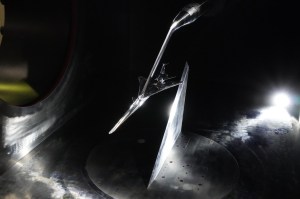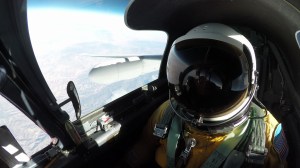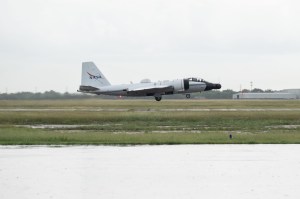Providing seamlessly connected information and decision-making tools to help future air mobility meet its full potential for society.
Imagine a not-too-distant future in which a self-operating drone is on its way to deliver goods, taxi people across town, or even help locate wildfires. To safely complete its flight, that drone will require important information – such as a notice of deteriorating weather conditions – that might prompt it to change its course. For that, it could rely on a new capability that NASA researchers are exploring that would enable the distribution of many kinds of information in flight and help the aircraft make the right decisions in response.
That capability is the idea behind DRF, or Data & Reasoning Fabric – a NASA activity exploring if it’s possible to create an information infrastructure that can help assemble useful data and reasoning services to provide in-time information to autonomous aircraft for decision making. The intent is to form a connected, interwoven “fabric” of intelligence that sends aircraft specific, tailored information, wherever they are. This infrastructure would enable the vision of a “smart” city and airspace. While this project is focused on future autonomous systems, DRF could even be applied to traditional transport systems.
Decision Support for Drones
DRF’s vision is to provide seamless access both to services offering data and to tools for making decisions based on that data. The latter is the “reasoning” in Data & Reasoning Fabric.
Many people are already familiar with a reasoning service, in the form of a navigation app on their phone. Different kinds of data – maps, accident reports, traffic conditions, roadwork status – are drawn in by the app, which then sorts through it all and tells the driver the best route to take at the time.
Decisions needed by autonomous aircraft of the future could be made in a similar way. The information made available by DRF’s “fabric” will have the data and reasoning needed to make critical safety decisions rapidly.
Future Marketplaces – of Data and Decisions – to Support Air Mobility
NASA envisions a future air transportation system that moves people and cargo between places previously not served or underserved by aviation – think regional services, or in urban settings – using revolutionary new aircraft that are only just now becoming possible. Efforts toward this goal are called Advanced Air Mobility.
As these aircraft become more autonomous, they’ll need more and more data, along with the reasoning tools to make decisions using that information. To make many disparate types of data and reasoning services available to aircraft, there will need to be a way of connecting them to a multitude of data providers.
So, where does this data and reasoning come from and how is it accessed?
DRF envisions a digital “marketplace” where providers like weather services, mapping and surveying firms, air traffic management, and others can offer their data and reasoning services to aircraft operators via digital agreements. In turn, operators can also offer the data and reasoning they have acquired.
DRF in Action: A Delivery Drone Example
When a delivery drone receives orders to take a package to an address downtown, it connects to the Data & Reasoning Fabric.
A nearby data node provides the drone with information from a weather station, a detailed map from city authorities, and the locations of nearby aircraft, all assembled using data from the marketplace.
Receiving this information from DRF, the drone can understand with its own software that the weather is acceptable, that it should fly above 200 feet to avoid a building, and that it must allow room for an air taxi flying nearby. However, if there is dangerous weather, decision support tools enabled by DRF could provide the drone with a new flight route that avoids weather and obstacle dangers.
If all goes well with executing the DRF activity, drones will have the information and decision-support tools they need to take the safest and most efficient course of action with minimal human input.
DRF will address the needs of an Advanced Air Mobility system, but its vision is not only relevant to those air vehicles. It’s also applicable to the broader transportation network.
Completed Milestones
- Spring 2022: A series of field tests of DRF technologies took place in partnership with the Civil Air Patrol, California Wing.
- The NASA team studied how well DRF can help CAP tackle wildfires with the help of unmanned aviation systems, or drones, by enhancing safety and response times. During the tests, DRF’s tools helped simulated drones autonomously monitor forests and detected the first signs of wildfire.
- To help CAP optimize their current operations, the DRF team, in collaboration with the Universities Space Research Association (USRA) looked at how easily data and reasoning services can be accessed using their tools, and which elements made CAP’s response faster.
- March-June 2023: A multi-stakeholder demonstration involving the greater Phoenix metropolitan area showed how DRF can enhance and help users adapt to the evolving airspace of AAM.
- Autonomy Association International, NASA’s partner on this demo, gathered a variety of participants, including stakeholders from Maricopa County’s 22 cities, industry, and academia.
Partners
DRF is led out of NASA’s Ames Research Center in California’s Silicon Valley. An exploratory activity, DRF is part of NASA’s Convergent Aeronautics Solutions (CAS) project. CAS strives to provide breakthrough technological innovation in aeronautics, providing researchers the tools and resources to address the biggest challenges facing aviation today and into the future.
DRF’s stakeholders include data, reasoning, and infrastructure service providers, flight operators, and local to federal governments. DRF will establish external partnerships with service providers, academics, and end users to evaluate DRF capabilities. Additionally, these collaborations will help the DRF team develop approaches to overcome technical barriers to implementing future air mobility.
For researchers:
- Project website: Data & Reasoning Fabric
- Aeronautics Research Mission Directorate story: NASA Explores “Smart” Data for Autonomous World (June 2021)
- NASA Ames Aeronautics division story: Data & Reasoning Fabric (DRF)
- NASA’s Convergent Aeronautics Solutions project
For news media:
- Members of the news media interested in covering this topic should reach out to the Ames newsroom.




































